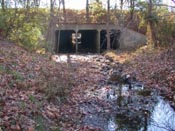
Tributary to Accotink Creek
|
A multiple-tracer investigation to identify sources of human wastewater inputs to a fecal coliform-contaminated stream
 Main channel of Accotink Creek |
Problem
Bacteria source tracking studies have consistently identified human-derived fecal coliform bacteria in Virginia’s streams and rivers. These human-derived bacteria constitute a human health hazard and present a challenge because the physical source of the human waste is not easy to identify. Human-derived bacteria may be delivered to streams because of failing septic systems, leaking or broken sewer lines, cross-connected pipes, straight pipes, and sewer line overflows. Previous research in Accotink Creek (a stream in northern Virginia that is listed on the State’s 303-D priority list because of violations of the fecal coliform bacteria standard) has identified a significant source of human-derived fecal coliform bacteria in the stream. As Total Maximum Daily Load (TMDL) Programs move into the implementation phase, a cost-effective approach for identifying site-specific sources of human waste must be developed and demonstrated.
Objectives
1. Demonstrate the utility of a multiple-tracer approach for tracking the sources of human wastewater that have been observed in Accotink Creek.
2. Identify the distribution and specific sources of the human wastewater signal within the Accotink Creek watershed by evaluating the contributions from storm drains, stream tributaries, and regions of diffuse subsurface flow into the Creek.
Relevance and Benefits
Identification of the specific sources of
human-wastewater inputs to streams will be required in the implementation
phase of many of the TMDLs under development throughout the Commonwealth. This investigation will result in a direct improvement in the
water quality of Accotink Creek and it will demonstrate cost-effective
methods for wastewater identification that can be applied throughout
Virginia.
Approach
We are applying a broad selection of chemical and biological tracer techniques and utilizing a holistic sampling approach to study the sources of human wastewater in Accotink Creek. The tracers being used to identify inputs of human wastewater to streams include chloride, bromide, boron, specific conductance, water temperature, turbidity, dissolved oxygen, surfactants, optical brighteners, and fecal coliform bacteria. Additional tracers of human wastewater that are being used during this study include bacteria source tracking (BST) and an analysis of organic compounds that are frequently associated with human wastewater (caffeine, for example). To identify the sources that contribute human wastewater to Accotink Creek, we are intensively sampling the entire watershed, including the storm drains, tributaries, and the main channel of Accotink Creek.
